How Has History Affected the People of Eastern Europe & Russia?
Who Are the People of Eastern Europe?, What Is Eastern Europe Like Today?
Poland and the Baltic Republics. Study the map. Look for the countries around the Baltic Sea. You will see Poland. Now find Estonia, Latvia, and Lithuania. They make up the Baltic Republics.
This area was settled in ancient times. Many different ethnic groups lived here. Ethnic groups are people who share the same or similar language. They also share a common culture, religion, and history. For example, most Polish people belong to the Roman Catholic religion.
In ancient times, different groups settled this area. The people formed many kingdoms. Among these kingdoms were the Polish, Lithuanians, Estonians, and Latvians. Each has their own culture and language.
In the Middle Ages to about the 1800s, this area ruled most of Northern and Eastern Europe. In the 1900s, the Baltic region was often invaded. They were the site of some of the worst battles of World War I and II. Russia was known as the Soviet Union. It conquered and controlled the countries until 1991, when the Baltic Republics gained their freedom again.
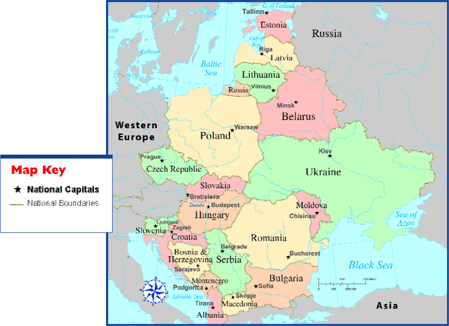 Political Map of Eastern Europe
Political Map of Eastern Europe
Inland Eastern Europe. Find the Czech Republic, Slovakia, Ukraine, Hungary, Belarus, and Moldova. These countries make up inland Eastern Europe. Many small kingdoms also ruled this area. People called the Slavs created these kingdoms. The Slavs were from Asia. People in Eastern Europe are called Slavs because of the language they speak and their customs.
The Slavs also settled Moldova, Belarus, and Ukraine. In the 900s, the Magyars settled Hungary. They came from central Asia. Like the Baltic region, many ethnic groups make up inland Eastern Europe.
The Balkan Countries. The Balkan Peninsula lies between the Adriatic Sea and the Black Sea. Albania, Romania, Bulgaria, and the former Yugoslavia make up the Balkan region.
Like the rest of Eastern Europe, the Balkan region has been ruled by many different groups. The ancient Greeks settled this area. Later, Muslim Ottoman Turks conquered it.
Russia. European Russia is west of the Ural Mountains. The Slavs were one of the groups that settled parts of Russia. In the 800s, Vikings from Scandinavia invaded the Slavs.
Later Mongols from Asia invaded Russia. They let Russian princes rule over states. In time, these princes and czars built Russia into a huge empire.
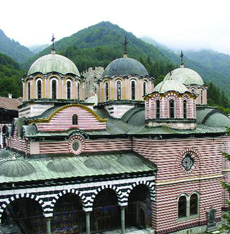 The Rila Monastery, Bulgaria
The Rila Monastery, Bulgaria
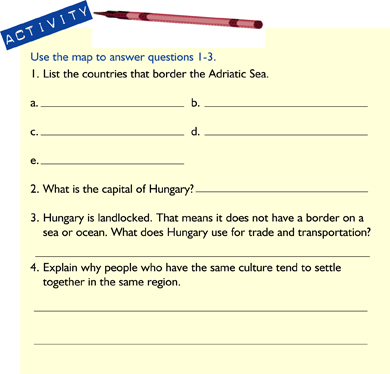
Who Are the People of Eastern Europe?
The people of Eastern Europe have proud histories. The famous astronomer Copernicus was born in Poland. Mother Theresa was born in Macedonia. She devoted herself to working among the poorest of the poor in the slums of Calcutta, India. Many famous writers, poets, and artists come from Eastern Europe.
Different ethnic groups have given Eastern Europe a special flavor. Hungary gives us red paprika for cooking. It is the national spice made from peppers. We can travel to the Czech Republic for roast pork and dumplings. The Baltic Republics are famous for potatoes and sausage.
Yet life has not been easy for the people of Eastern Europe. World War II tore Europe apart. When the war ended, the United States and the Soviet Union were the most powerful nations. They did not trust each other. The Soviet Union conquered most of Eastern Europe and kept it until 1989. The Soviet Union was a communist country. Communism is a political and economic system. They believe that the government . should control the economy and people so that all goods are shared by the people. This idea never really came true.
This period of tension is called the Cold War. It lasted until the 1980s. The Cold War divided Europe into East and West. Countries in the East were communist. Countries in the West were non-communist.
The Soviet (USSR) Union ruled Eastern Europe. The people could not vote for their leaders. They could not own land or businesses. Everyone worked for the government. The government planned where people worked. It told them what to make. It told them what crops to grow. There was no free enterprise. In a free enterprise economy, people own their own businesses. People were not allowed freedom of speech or to practice a religion.
In 1991, the Soviet Union broke apart. Many countries won their independence. Some of the changes have been peaceful. Other changes have led to war. Tension between ethnic groups is still rising.
Still, many people's lives are better. Today, people are looking for closer ties to Europe and the European Union.
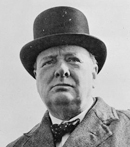
Primary Sources
The war in Europe had ended. British prime minister Winston Churchill had this to say about the split happening in Europe.
From … the Baltic to … the Adriatic an iron curtain has descended [dropped] across the Continent. Behind that line lie all the capitals of the ancient states of Central and Eastern Europe…. All these famous cities and the populations around them lie in … the Soviet sphere, and all are subject … not only to Soviet influence but … to the control of Moscow.
From Winston Churchill's speech. Given at Westminster College, Fulton, Missouri, 1946.
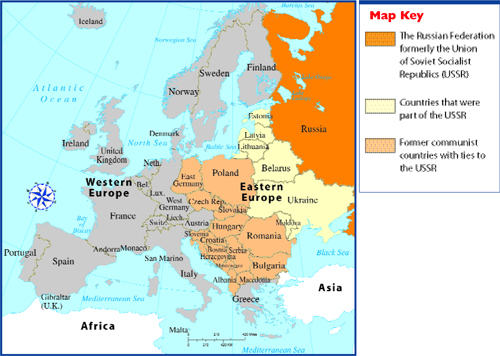 Eastern Europe and the Power of Russia (formerly the USSR)
Eastern Europe and the Power of Russia (formerly the USSR)
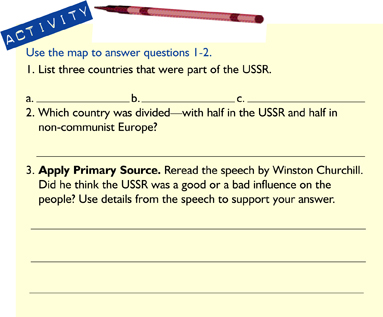
What Is Eastern Europe Like Today?
Life is improving for many people in Eastern Europe. Poland and the Baltic Republics are improving their economies. Many countries have an economy based on supply and demand. This means that the price of goods rise and fall depending on how many people want them (demand) and how many of the goods are available (supply). The people are building new factories. In some countries, the people elect their own leaders. Many have growing industries and economies.
Visitors now come to see these countries. They learn about the rich history and customs of the people. They spend their money in the countries they visit. The money these tourists spend helps improve the country's economy.
Today, Russia is no longer a communist country. It has a market economy. A market economy is based on free trade and competition. Businesses decide how much to make and what to sell it for. The government has little to say about what the businesses do. Tourists also come to visit the wonderful old cities and museums.
Some of the Balkan countries still have conflict. In this area, there are many religions, languages, and customs. After WW I, the country of Yugoslavia was formed. However, long and bitter quarrels continued among ethnic groups.
In the 1990s, these fights tore the country apart. Five new countries were born. They were Slovenia, Croatia, Bosnia and Herzegovina (bahz-nee-uh and hehrt-seh-gaw-vee-nuh), Serbia and Montenegro, and Macedonia.
The wars continued. Serbia wanted to control the other new republics. Bitter fighting continued until 2002. Everyone suffered. There are still ethnic groups who want their own nation. This feeling of nationalism makes some people believe that Eastern Europe might break up into more republics.
However, more and more countries are working to join the European Union. This will help them improve their standard of living and the lives of their citizens.
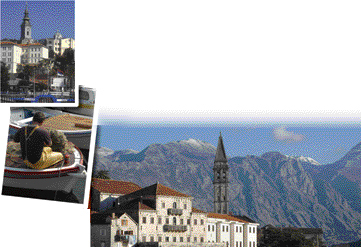 Belgrade, Serbia
Belgrade, Serbia
A fisherman in Croatia
Perast, Montenegro
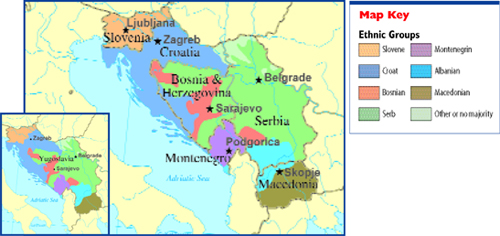 The Former Yugoslavia, 2006
The Former Yugoslavia, 2006
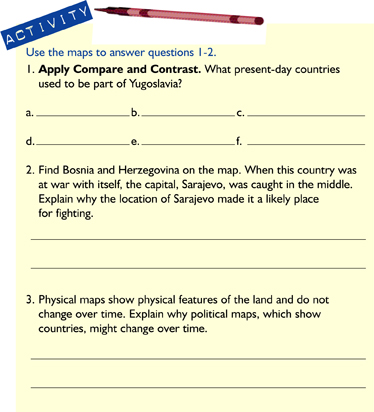
Additional topics
- Looking At ITALY - Where in the World Is Italy?, What Is the Geography of Italy?
- How Has History Affected the People of Western Europe? - Who Are the People of Western Europe?, What Is Western Europe Like Today?
- Other Free Encyclopedias
History Reference: Ancient History & World HistoryThe Eastern Hemisphere - Europe and Russia

